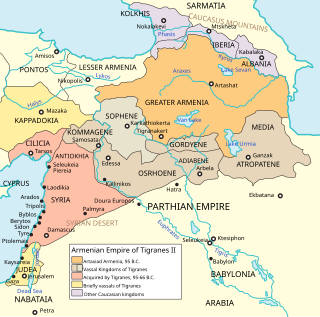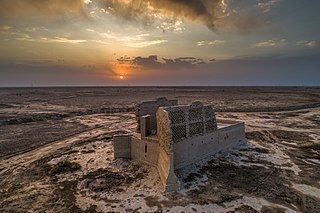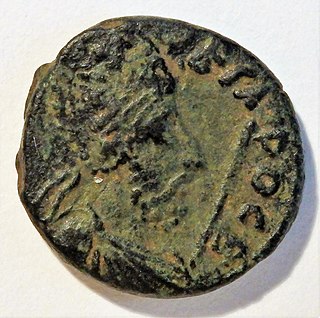Related Research Articles
This article concerns the period 29 BC – 20 BC.

Abgar V, called Ukkāmā, was the King of Osroene with his capital at Edessa.

A dynasty is a sequence of rulers from the same family, usually in the context of a monarchical system, but sometimes also appearing in republics. A dynasty may also be referred to as a "house", "family" or "clan", among others.

Osroene or Osrhoene was an ancient region and state in Upper Mesopotamia. The Kingdom of Osroene, also known as the "Kingdom of Edessa", according to the name of its capital city, existed from the 2nd century BC, up to the 3rd century AD, and was ruled by the Abgarid dynasty. Generally allied with the Parthians, the Kingdom of Osroene enjoyed semi-autonomy to complete independence from the years of 132 BC to AD 214. Though ruled by a dynasty of Arab origin, the kingdom's population was of mixed culture, being Syriac-speaking from the earliest times. The city's cultural setting was fundamentally Syriac, alongside strong Greek and Parthian influences, though some Arab cults were also attested at Edessa.

Edessa was an ancient city (polis) in Upper Mesopotamia, in what is now Urfa or Şanlıurfa, Turkey. It was founded during the Hellenistic period by King Seleucus I Nicator, founder of the Seleucid Empire. It later became capital of the Kingdom of Osroene, and continued as capital of the Roman province of Osroene. In Late Antiquity, it became a prominent center of Christian learning and seat of the Catechetical School of Edessa. During the Crusades, it was the capital of the County of Edessa.
Idris (I) ibn Abd Allah, also known as Idris the Elder, was an Arab Hasanid Sharif and the founder of the Idrisid dynasty in part of northern Morocco, in alliance with the Berber tribe of Awraba, after fleeing the Hejaz as a result of the Battle of Fakhkh.

Vologases IV was King of Kings of the Parthian Empire from 147 to 191. He was the son of Mithridates V. Vologases spent the early years of his reign re-asserting Parthian control over the Kingdom of Characene. From 161 to 166, he waged war against the Roman Empire; although initially successful, conquering Armenia and Syria, he was eventually pushed back, briefly losing control of the Parthian capitals of Seleucia and Ctesiphon to the Romans. The Romans suffered heavy losses from a plague erupting from Seleucia in 166, forcing them to withdraw. The war ended soon afterward, with Vologases losing most of northern Mesopotamia to the Romans. He died in 191 and was succeeded by his son Vologases V.

Abhar is a city in the Central District of Abhar County, Zanjan province, Iran, and serves as capital of both the county and the district.
Abgar II was the Abgarid king of Osroene from 68 to 53 BC. Plutarch describes Abgar as a chief of the Arabs.

Sakastan was a Sasanian province in Late Antiquity, that lay within the kust of Nemroz. The province bordered Kirman in the west, Spahan in the north west, Kushanshahr in the north east, and Turan in the south east. The governor of the province held the title of marzban. The governor also held the title of "Sakanshah" until the title was abolished in ca. 459/60.

The Emesenedynasty, also called the Sampsigeramids or the Sampsigerami or the House of Sampsigeramus, were a Roman client dynasty of Syrian priest-kings known to have ruled by 46 BC from Arethusa and later from Emesa, Syria, until between 72 and 78/79, or at the latest the reign of Emperor Antoninus Pius (138–161). Iamblichus, the famous Neoplatonist philosopher of the third century, was one of their descendants, as was empress Julia Domna, matriarch of the Severan dynasty.

Commagene was an ancient Greco-Iranian kingdom ruled by a Hellenized branch of the Iranian Orontid dynasty that had ruled over Armenia. The kingdom was located in and around the ancient city of Samosata, which served as its capital. The Iron Age name of Samosata, Kummuh, probably gives its name to Commagene.

Sistān, also known as Sakastān and Sijistan, is a historical region in present-day south-western Afghanistan and south-eastern Iran. Largely desert, the region is bisected by the Helmand River, the largest river in Afghanistan, which empties into the Hamun Lake that forms part of the border between Iran and Afghanistan.

Abgar VIII of Edessa, also known as Abgar the Great or Abgar bar Ma'nu, was an Arab king of Osroene from 177 CE to 212 CE.

The Parthian war of Caracalla was an unsuccessful campaign by the Roman Empire under Caracalla against the Parthian Empire in 216–17 AD. It was the climax of a four-year period, starting in 213, when Caracalla pursued a lengthy campaign in central and eastern Europe and the Near East. After intervening to overthrow rulers in client kingdoms adjoining Parthia, he invaded in 216 using an abortive wedding proposal to the Parthian king Artabanus's daughter as a casus belli. His forces carried out a campaign of massacres in the northern regions of the Parthian Empire before withdrawing to Asia Minor, where he was assassinated in April 217. The war was ended the following year after Parthian victory at the Battle of Nisibis, with the Romans paying a huge sum of war reparations to the Parthians.
Abd al-Hamid ibn Ahmad ibn Abd al-Samad Shirazi, better known as Abd al-Hamid Shirazi, was a Persian vizier of the Ghaznavid Sultan Ibrahim and the latter's son Mas'ud III.

Osroene, also spelled Osrohene and Osrhoene, was a Roman province which existed for nearly 400 years. It was formed after the absorption of the Kingdom of Osroene in 214 CE and served as a frontier province against the Sassanid Empire until the Muslim conquests of the 7th century.
The siege of Edessa took place in 165 when the Roman Empire, under Emperor Lucius Verus, besieged the city of Edessa, held by the Parthian Empire.
The siege of Edessa took place in 163 when the Parthian Empire, under Vologases IV, besieged the city of Edessa, held by the Roman Empire.
References
- 1 2 Ramelli 2018.
- ↑ Sartre 2005, p. 500.
- 1 2 3 4 5 6 7 8 9 Segal 1982, pp. 210–213.
- ↑ Sartre 2005, p. 508.